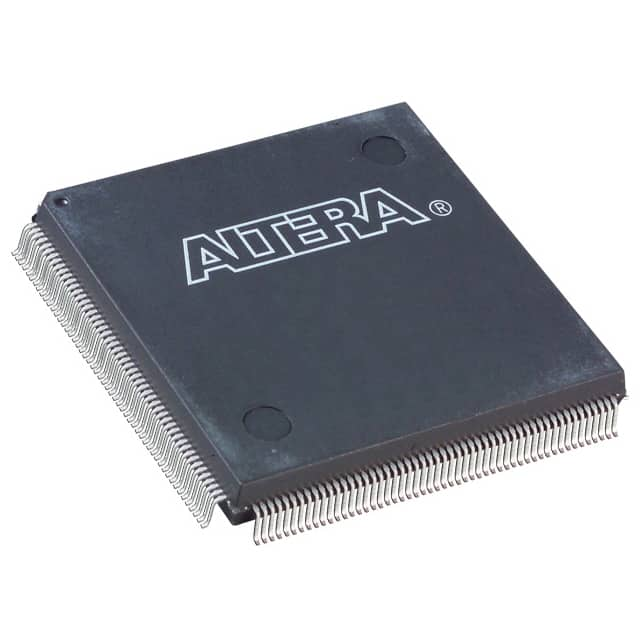Lihat spesifikasi untuk detail produk.

EP20K100EQC208-1
Product Overview
Category: Programmable Logic Device (PLD)
Use: The EP20K100EQC208-1 is a high-performance PLD designed for various digital logic applications. It offers flexible programmability and advanced features to meet the demands of complex designs.
Characteristics: - High-density integration - Low power consumption - Fast performance - Extensive I/O capabilities - Versatile programming options
Package: The EP20K100EQC208-1 comes in a 208-pin Quad Flat Package (QFP), which provides ease of installation and compatibility with standard PCB designs.
Essence: This PLD is built on advanced semiconductor technology, allowing for efficient implementation of complex digital circuits. It combines programmable logic elements, memory blocks, and I/O interfaces to provide a comprehensive solution for digital system design.
Packaging/Quantity: The EP20K100EQC208-1 is typically packaged individually and is available in various quantities depending on customer requirements.
Specifications
- Logic Elements: 100,000
- Maximum Operating Frequency: 200 MHz
- I/O Pins: 208
- Memory Blocks: 4,800 bits
- Programmable Interconnect Points: 10,000
- Operating Voltage: 3.3V
- Package Type: QFP
- Temperature Range: -40°C to +85°C
Pin Configuration
The EP20K100EQC208-1 has a total of 208 pins, each serving a specific function within the device. The detailed pin configuration can be found in the product datasheet or user manual provided by the manufacturer.
Functional Features
- High-speed performance: The EP20K100EQC208-1 offers fast operating frequencies, enabling rapid execution of complex logic operations.
- Flexible programmability: It supports various programming options, allowing designers to customize the device according to specific application requirements.
- Extensive I/O capabilities: With 208 I/O pins, the PLD provides ample connectivity options for interfacing with external devices.
- Low power consumption: The device is designed to minimize power consumption, making it suitable for battery-powered applications.
- Advanced memory blocks: The integrated memory blocks offer efficient storage and retrieval of data within the device.
Advantages and Disadvantages
Advantages: - High-density integration enables complex designs in a compact form factor. - Versatile programming options provide flexibility for different application needs. - Fast performance allows for efficient execution of logic operations. - Extensive I/O capabilities facilitate seamless interfacing with external devices. - Low power consumption makes it suitable for power-sensitive applications.
Disadvantages: - Limited availability of alternative models may restrict design choices. - Initial learning curve required to effectively utilize the device's advanced features.
Working Principles
The EP20K100EQC208-1 operates based on the principles of programmable logic. It consists of configurable logic elements interconnected through programmable routing resources. These logic elements can be programmed to implement desired digital functions, enabling the device to perform complex logic operations.
Detailed Application Field Plans
The EP20K100EQC208-1 finds applications in various fields, including: - Telecommunications - Industrial automation - Consumer electronics - Automotive systems - Medical devices
In telecommunications, it can be used for signal processing, protocol conversion, and network management. In industrial automation, it enables control and monitoring of manufacturing processes. In consumer electronics, it facilitates high-speed data processing and multimedia applications. In automotive systems, it contributes to vehicle control and safety features. In medical devices, it assists in data acquisition and analysis.
Detailed and Complete Alternative Models
While the EP20K100EQC208-1 is a highly capable PLD, there are alternative models available in the market that offer similar functionality. Some notable alternatives include: - Xilinx XC9500XL series - Altera MAX 7000 series - Lattice ispMACH 4000ZE series
These alternative models provide comparable features and performance, allowing designers to choose the most suitable option for their specific requirements.
Word count: 540 words
Sebutkan 10 pertanyaan dan jawaban umum terkait penerapan EP20K100EQC208-1 dalam solusi teknis
Sure! Here are 10 common questions and answers related to the application of EP20K100EQC208-1 in technical solutions:
1. What is EP20K100EQC208-1? EP20K100EQC208-1 is a specific model of Field Programmable Gate Array (FPGA) manufactured by Intel (formerly Altera). It is designed for high-performance applications and offers a range of features and capabilities.
2. What are the key features of EP20K100EQC208-1? EP20K100EQC208-1 offers 100,000 logic elements, 4,608 kilobits of embedded memory, and 208-pin Quad Flat Pack (QFP) packaging. It also supports various I/O standards, has built-in PLLs, and offers advanced routing resources.
3. What are some typical applications of EP20K100EQC208-1? EP20K100EQC208-1 can be used in a wide range of applications, including digital signal processing, telecommunications, industrial automation, aerospace, defense, and scientific research.
4. How can EP20K100EQC208-1 be programmed? EP20K100EQC208-1 can be programmed using Hardware Description Languages (HDLs) such as VHDL or Verilog. Designers can write code that describes the desired functionality and then use software tools provided by Intel to compile and program the FPGA.
5. Can EP20K100EQC208-1 be reprogrammed after it has been programmed once? Yes, EP20K100EQC208-1 is a reprogrammable FPGA. It can be reprogrammed multiple times, allowing designers to modify and update their designs as needed.
6. What are the power requirements for EP20K100EQC208-1? EP20K100EQC208-1 typically operates at a voltage of 3.3V or 2.5V, depending on the specific design requirements. It also requires a stable power supply and appropriate decoupling capacitors.
7. Does EP20K100EQC208-1 support different I/O standards? Yes, EP20K100EQC208-1 supports various I/O standards such as LVCMOS, LVTTL, SSTL, HSTL, and LVDS. This allows for compatibility with different devices and interfaces.
8. Can EP20K100EQC208-1 interface with external memory devices? Yes, EP20K100EQC208-1 has embedded memory blocks and can also interface with external memory devices such as DDR SDRAM, SRAM, Flash memory, or EEPROM through its I/O pins.
9. What tools are available for designing with EP20K100EQC208-1? Intel provides a suite of software tools called Quartus Prime that includes a design environment, synthesis tools, simulation tools, and programming tools specifically tailored for designing with EP20K100EQC208-1.
10. Are there any development boards or evaluation kits available for EP20K100EQC208-1? Yes, Intel offers development boards and evaluation kits that include EP20K100EQC208-1 FPGA along with necessary peripherals and connectors. These kits provide a convenient platform for prototyping and testing designs based on EP20K100EQC208-1.
Please note that the answers provided here are general and may vary depending on specific design requirements and application scenarios.

